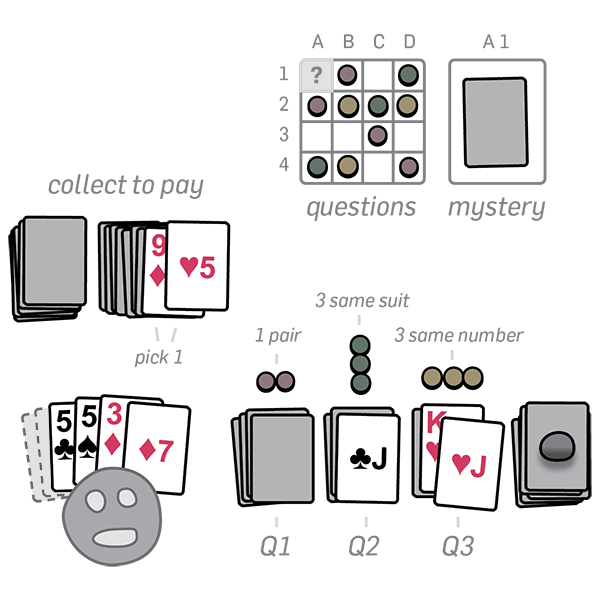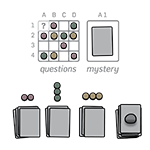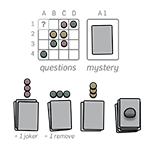-
Mystery MachineA puzzle card game for 1 player.
![Mystery Machine]()
-
- 2024
-
- Type:
- Puzzle / Solitaire
- Players:
- Difficulty:
- Ext. Diff.:
-
- Version
- 1.0
- Updated on
- 18 Apr 2024
- In Finnish:
- Mysteerimasiina
- Sibling games:
- Suit Nations, Suit Taboo
- Table of contents
- Optional rules:
(extension) Puzzle Mods
-
-
BASICS
REQUIREMENTS
- 1 player.
- Normal deck of 52 cards. (Optionally a couple of jokers with extensions.)
- Some coins (or other tokens) in a few categories (about 3 or 4 categories, each with about 4 - 6 tokens).
BASIC IDEA
Mystery Machine is a puzzle game that also serves as a playground for creating puzzles (a mix of sudoku and solitaire). The game has 3 steps:
- A puzzle is picked and determines how tokens are placed on the puzzle grid. The player's goal is to figure out the mystery card in the A1 slot.
- Each row of the grid represents a rank, but the order is shuffled. Likewise the columns of the grid imply suits, but are shuffled.
- Next to the grid, there is a question shop for each token type (indicated by color), and each has its own price (= a card combo) for buying knowledge.
- During the game the player can "buy" knowledge with fitting low card (2 - 10) combos. As a result, the shop's topmost face down is turned face up.
- There's an initial dealing routine that transforms an initially ordered set of face cards and aces into a carefully shuffled deck (see further below).
- The deck is dealt into the respective shops (by token type), the off-pile (= no token) or A1 mystery holder - row by row and cell by cell (A1, A2, A3, A4, B1, B2, ...).
- The game is played by collecting cards from the low deck (2 - 10): always picking 1 out of 2, and then asking questions to gradually solve the puzzle.
- If the player can solve the puzzle (by guessing which card A1 is) before the deck runs out, he wins. Otherwise it's a loss.
-
SETUP
PUZZLE GRID
You can sketch out a puzzle in place or use one of the examples here - see Puzzles below.
- PUZZLE GRID: The grid is drawn on a piece of paper and puzzle laid using a few different looking coins (or other tokens) to fill the cells.
- Each cell should only have 1 coin, and some are usually left empty. (If you run out of coin categories, you can also combine 2 different coins as a new symbol.)
- Create one reusable 4x4 grid on an A5 paper, where each cell is about 1 x 1 inch. Next to the grid, draw a rectangle large enough to fit a playing card.
- QUESTION PRICE: Part of the puzzle design is to define the price for each question type, which is indicated by tokens placed behind each pile.
- SAME NUMBER: Same number prices are marked by placing 2-4 tokens in a row - the count implies how many required. (4 same is very expensive, 1 pair cheap.)
- 2 x SAME NUMBER: 2 pairs or a full house (= 1 pair + 3 same number) are marked by two rows respectively. (These are very expensive.)
- SAME SUIT: Same suit prices are marked by placing 2-4 tokens in a column. (Most often 3 same suit - middle priced.)
- STRAIGHT FLUSH: Price for same suit with subsequent numbers is marked by 2-4 tokens overlapping each other in a column. (These are very expensive.)
DEALING MECHANISM
This mechanism shuffles the ordered cards (= 4 x J, Q, K, A) by columns and rows and finally deals them into question piles.
- INITIAL GRID: The included cards (= at least 4 numbers with all 4 suits) are placed face up into piles by their suit in the same order (usually from ace down).
- SHUFFLING SUITS: The player turns the piles face side down and starts moving them around on the table until no longer knows which is which.
- With a rotating tray, place cards on it, rotate, swap some, rotate again, and swap until satisfied. Or with someone, both can quickly shuffle (= neither knows).
- REGROUPING: The first suit pile is laid as a row (face down from left to right), and then the other suit piles are laid above in the same order (into new piles).
- SHUFFLING NUMBERS: The new rank piles are then shuffled just like was done in step 2 above. (There are as many piles as ranks included in the setup.)
- QUESTION PILES: Finally, the rank piles are (piled into one and) dealt one by one into the question piles according to the picked puzzle.
- The cards are dealt one by one going over the grid left to right, row by row. The first card goes to the mystery A1 holder.
- The remaining cards are dealt to the shops according to the token type in the grid, or to the empty shop (= no token) on which a stone is placed after. Finally, the cards in each shop are shuffled - except the empty shop (as it remains inaccessible during the game).
- PUZZLE GRID: The grid is drawn on a piece of paper and puzzle laid using a few different looking coins (or other tokens) to fill the cells.
-
PLAYING
ON A TURN
The game proceeds by collecting cards from the low deck (numbers 2 - 10). The deck is shuffled and 2 cards are turned face up.
- PICK A CARD: The player takes one of the two cards (face up in front of him) and dumps the other (face down aside), and then draws 2 new cards (when ready).
- The player can collect up to 6 cards. Upon collecting the 7th card, one of the earlier collected cards is dumped.
- ASK QUESTIONS: You can use the collected cards to pay question prices. You can ask as many in a turn as you can (before and/or after picking).
- After paying the price, the used low cards are dumped and the topmost face down card in the targeted question pile is turned face up (and put on top).
- SOLVE / GUESS: Finally, when the player thinks he's figured it all out (or the low deck runs out), he can declare the suit and number of the mystery card.
- The card is turned around and if correct, the player wins - otherwise he loses and the game is over. (You can also redo the puzzle without reshuffling the grid cards.)
- You can optionally measure the success of each try by how many cards were left in the low deck after a correct answer.
- PICK A CARD: The player takes one of the two cards (face up in front of him) and dumps the other (face down aside), and then draws 2 new cards (when ready).
-
-
extension: PUZZLE MODS
This extension features a few extra tools for the puzzle designer. With all included, the puzzle process is:
- Initial grid face up. Cards are turned face down into suit piles.
- Shuffling suit piles.
- Regrouping (XY flip for suits and numbers).
- Shuffling number piles.
- Perform Grid Twists.
- Form question piles (and shuffle them).
- Perform Random Removals and finally Random Adds. (The puzzle design decides which first.)
puzzle mod: EXTENDED GRID
You can also extend the grid by including some low numbers (eg. 10, 9, ...), but the player will have fewer cards to draw.
puzzle mod: EXTENDED MYSTERY
There can alternatively be multiple mystery cards (eg. A1 and A2). The mystery slots can be picked freely, but are typically A1 and near it.
puzzle mod: RANDOM REMOVALS
The puzzle designs can include discarding some cards from certain question piles.
- After shuffling the question pile, the removed card(s) are simply moved (face down) under the stone pile.
- Alternatively, the removed card(s) can become the mystery card(s), so the mystery slots are not fully known. (You can add back empty answers with jokers.)
puzzle mod: RANDOM ADDS (joker)
The puzzle designs can include adding empty answers into question piles using jokers.
- 1 or 2 jokers are included into a question pile (face down) before shuffling it. (Or it's shuffled again, if uses Random Removals in between.)
puzzle mod: GRID TWISTS
This extension introduces grid twists (marked with matches on the grid) that are performed right before forming the question piles.
- Note. To help visualize the swaps, you can optionally lay the number piles into a grid (row by row), do the swaps, and then form question piles.
- JOKER SWAP: Cards can be replaced by jokers (face down), taking the replaced card(s) as the mystery. (Can also do this with Random Removal + Add in one pile.)
- SWAPPING: Two cards of the same suit / number can be swapped. Marked with two matches side by side but opposite ways.
- SHIFTING: Three or more cards of the same suit / number can be shifted one step (the last one becomes first one). Marked with two or more matches placed longitudinally across two cells each (matchheads pointing the same way).
- SHUFFLING: Two or more cards (from anywhere in the grid) can be shuffled and placed back. Marked by a broken match placed as an X on the cell.
-
-
PUZZLES
PAR PUZZLES
These are example puzzles that feature a par for optimum number of questions asked. The below legend visualizes the question pile prices.
![Legend for prices Legend for prices]()
puzzle (par 4.5): WELCOME MUSHY HEADS
- Uses normal 4x4 grid. The A1 slot is the mystery card. Can get it with about 4 or 5 questions.
- Q1 pile has 4 cards and price is 1 pair. Uses cells: A2, B1, C3, D4.
- Q2 pile has 3 cards and price is 3 same suit. Uses cells: A4, C2, D1.
- Q3 pile has 3 cards and price is 3 same number. Uses cells: B4, B2, D2.
![Welcome Mushy Heads Welcome Mushy Heads]()
puzzle (par 4.5): THE THREE TWO'S
- Uses normal 4x4 grid. One card is replaced with a joker. Uses cells: A1 (the topmost card of the first number pile). The goal is to find which (par 4.5).
- Q1 pile has 3 cards and price is 3 same suit. Uses cells: B2, C2 - one joker is added as an empty answer.
- Q2 pile has 2 cards and price is 3 same number. Uses cells: A4, B3, D1 - one is discarded with Random Removal.
- Q3 pile has 2 cards and price is 3 straight flush. Uses cells: C1, C3.
![The Three Two's The Three Two"s]()
puzzle (par 4): ONE, TWO, THREE
- Uses normal 4x4 grid. The A1-A2 slots are the mystery cards. Figure out with about 4 questions.
- Q1 pile has 1 card and price is 3 straight flush. Uses cells: B1, C4.
- Q2 pile has 2 cards and price is 2 pairs. Uses cells: A4, B3, D1 - one is discarded with Random Removal.
- Q3 pile has 3 cards and price is 3 same suit. Uses cells: B4, C3, D2.
![One, Two, Three One, Two, Three]()
-
-
STRATEGY
PUZZLE DESIGN
- Any question piles that have only fully non-matching cards should be very expensive: as every answer is very revealing and can ruin things easily.
- This is even more so if you pick, say 3 cards, and each are different suit and number from each other and from the mystery card. However, with extensions, by discarding 2 of these cards, and/or moving them around, things can get more interesting (-> cheaper price), though more complex.
- On the other hand, any single question piles can be very revealing as well, especially if the same suit or number with the mystery.
- To finalize your puzzle design, figure out the few best strategical paths to solve it, and try playing the game. Adjust the puzzle difficulty by adjusting the prices, or sometimes by adjusting the puzzle grid. Feel free to share good puzzle designs by emailing them to:
infokoodikulmafi.
- Any question piles that have only fully non-matching cards should be very expensive: as every answer is very revealing and can ruin things easily.
-
-
HISTORY
v1 - Mystery Machine (2024-03-31 - 2024-04-18)
- v1.0 (2024-04-18): Added the low card deck part to complete the gameplay and make sense of it all (and removed Post Mixing from Puzzle Mods).
- v0.1 (2024-03-31): While exploring solitaire mechanisms, the vision of question piles and dealing mechanisms came up and evolved into this.
-
THANKS
INSPIRATION
The original inspiration comes from the inherent puzzliness of the universe.




